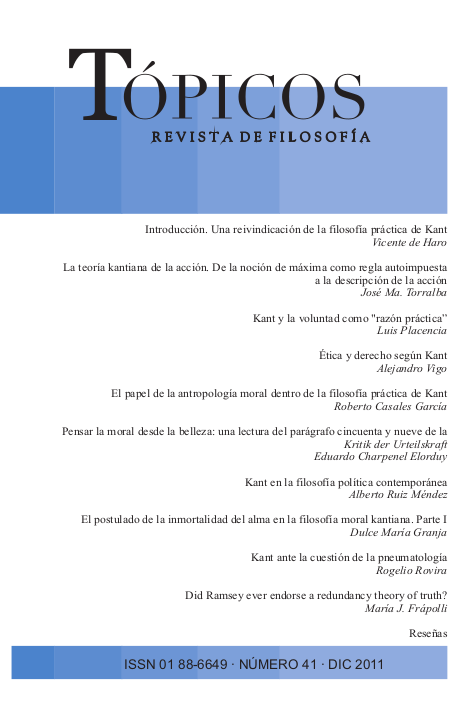Pensar la moral desde la belleza: Una lectura del parágrafo cincuenta y nueva de la Kritik der Urteilskraft
Pubblicato 2013-11-28
Parole chiave
- Kant,
- Kritik der Urteilskraft,
- estética,
- símbolo,
- belleza.
Come citare
Abstract
Mi objetivo en este artículo es estudiar el papel de la belleza como símbolo de la moralidad en la Kritik der Urteilskraft. En primer lugar, realizo una comparación entre el esquematismo de los conceptos y el proceso del razonamiento analógico. Lo que sostengo es que el razonamiento analógico y simbólico conduce en Kant a una consideración sobre los objetos bajo las condiciones establecidas por el agente reflexivo mismo: la tesis que mostraré con ello es que los objetos simbólicos contribuyen a los propios propósitos de reflexión de uno sobre una temática particular. Posteriormente, explico por qué Kant considera que la belleza es un símbolo adecuado de la moralidad en vistas de la existencia de un interesante número de similitudes entre el ámbito de lo estético y de lo moral. Finalmente, discuto por qué únicamente la libertad puede exhibirse por medio de un símbolo según la estética kantiana, y por qué las otras ideas de la razón—Dios y el alma—están mucho más asociadas con la experiencia de lo sublime.
Riferimenti bibliografici
- Allison, Henry: A Reading of the Critique of Aesthetic Judgment, Cambridge: Cambridge University Press 2001.
- Apel, Karl Otto: La transformación de la filosofía, vol. I, trad. José Antonio Capelo de Sousa Amaral, Madrid: Taurus 1985 (Transformation der Philosophie, Band I, Suhrkamp: Frankfurt am Main 1973).
- Burke, Edmund [1757]: A Philosophical Enquiry into our Ideas of the Sublime and Beautiful, Oxford: Oxford University 2009.
- Burwick, Frederick: “Art for Art’s Sake’ and the Politics of Prescinding: 1790’s, 1890’s, 1990’s.” Pacific Coast Philology XXXIV, 2, 1999.
- Descartes, René [1649]: Las pasiones del alma: trad. Alberto Palcos, México: Ediciones Coyoacán 2000 (Les Passions de l’âme).
- Ginsborg, Hannah: “Interesseloses Wohlgefallen und Algemeinheit ohne Begriffe”, Kritik der Urteilskraft. Kommentar. Berlin: Akademie Verlag 2008.
- Granja, Dulce María: “Las críticas de Hegel y Bernard Williams a la ética de Kant”, De acciones, deseos y razón práctica, México: Juan Pablós 2006.
- Granja, Dulce María: “El juicio reflexivo en la ética kantiana”, Diá- noia, XLII, no. 42, 1996.
- Guyer, Paul: “The Symbols of Freedom in Kant’s Aesthetics”, Kants Ästhetik-Kant’s Aesthetics-L’esthétique de Kant, New York: Walter de Gruyter 1998.
- Habernmas, Jürgen: “¿Afectan las objeciones de Hegel a Kant también a la ética del discurso?”, Escritos sobre moralidad y eticidad, trad. Manuel Jiménez Redondo, Barcelona: Paidós 1991 (Moralität und Sittlichkeit, Frankfurt am Main: Suhrkamp 1986).
- Hobbes, Thomas [1651]: Leviathan, Oxford: Oxford University Press 2009.
- Krausser, Peter: “Kant’s Schematism of the Categories and the Problem of Pattern Recognition”, Synthese, 33, 1976.
- Kulenkampff, Jens: Kants Logik des ästhetischen Urteils, Frankfurt am Main: Vittorio Klosterman 1994.
- Longuenesse, Béatrice: Kant and the Capacity to Judge, New Jersey: Princeton University Press 1998.
- Menzer, Paul: Kants Ästhetik in ihrer Entwicklung, Berlin: Akademie Verlag 1952.
- Pendlebury, Michael: “Making Sense of Kant’s Schematism”, Philosophy and Phenomenological Research, 55, 1995.
- Platón: Diálogos, IV, trad. Conrado Eggers Lan, Madrid: Gredos 1986.
- Rebentisch, Juliane: Ästhetik der Installation, Frankfurt am Main: Suhrkamp 2003.
- Recki, Birgit: Ästhetik der Sitten, Frankfurt am Main: Vittorio Klostermann 2001.
- Recki, Birgit: “Die Dialektik der äesthetischen Urteilskraft und die Methodenlehre des Geschmacks”, Kritik der Urteilskraft. Kommentar. Berlin: Akademie Verlag 2008.
- Rocca, Claudio: “Schematismus und Anwendung”, Kant-Studien, 80, 1989.
- Vigo, Alejandro: “Determinación y reflexión”, Anuario de filosofía XXXVII, 3, 2004.
- Weiland, Wolfgang: Urteil und Gefühl. Kants Theorie der Urteilskraft, Göttingen: Vandenhoeck & Ruprecht 2001.
- Wilcox, John: “The beginnings of l’Art pour l’Art”, The Journal of Aesthetics and Art Criticism 11, 1952.
- Williams, Bernard: “La moral y las emociones”, Problemas del yo, trad. José M.G. Holguera, México: UNAM (“Morality and the emotions”, Problems of the Self, Cambridge: Cambridge University Press 1973) 1986.
- Zammito, John H.: The Genesis of Kant’s Critique of Judgment, Chicago: Chicago University Press 1991.






